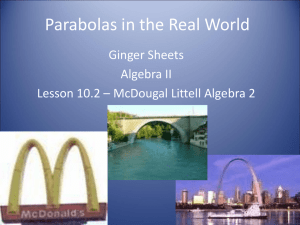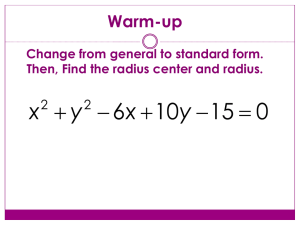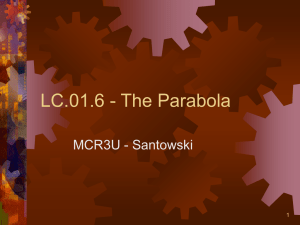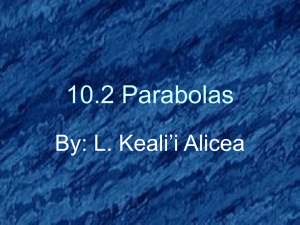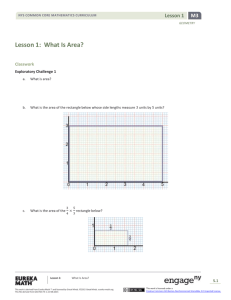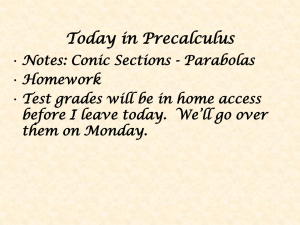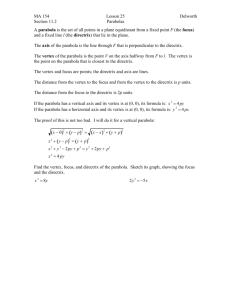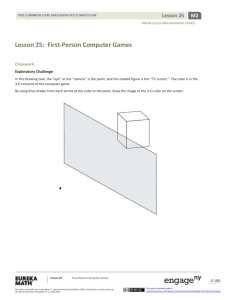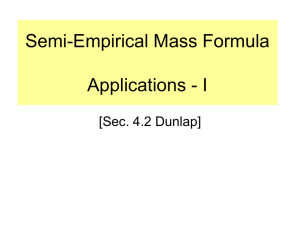Algebra II Module 1, Topic C, Lesson 35: Student Version
advertisement
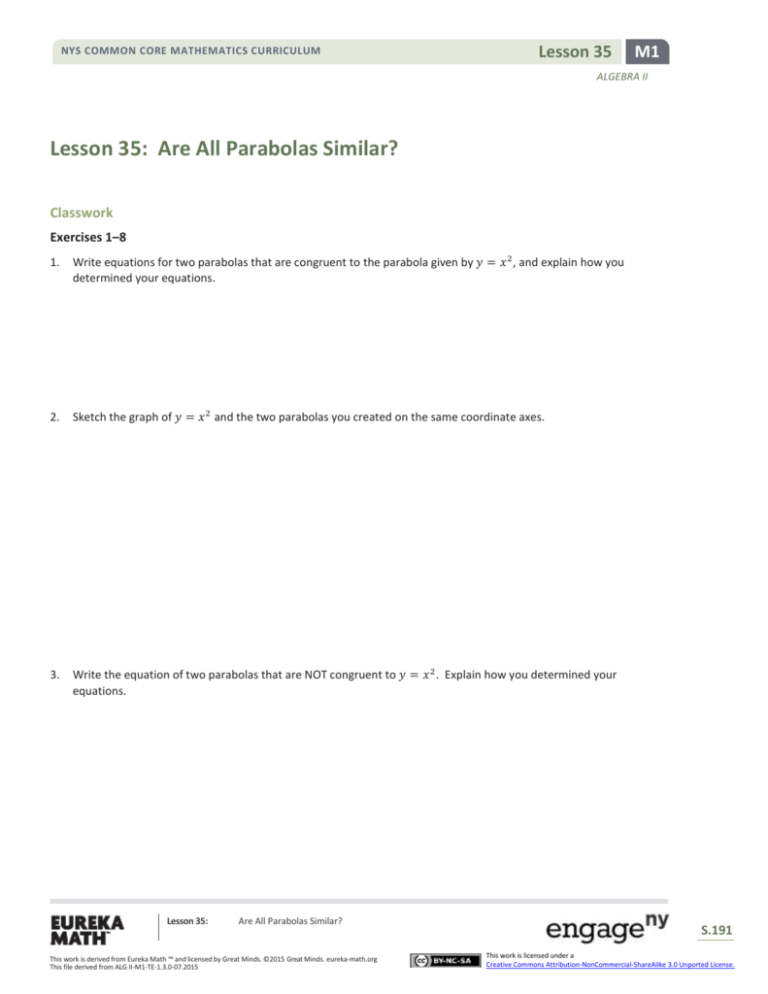
NYS COMMON CORE MATHEMATICS CURRICULUM Lesson 35 M1 ALGEBRA II Lesson 35: Are All Parabolas Similar? Classwork Exercises 1–8 1. Write equations for two parabolas that are congruent to the parabola given by 𝑦 = 𝑥 2 , and explain how you determined your equations. 2. Sketch the graph of 𝑦 = 𝑥 2 and the two parabolas you created on the same coordinate axes. 3. Write the equation of two parabolas that are NOT congruent to 𝑦 = 𝑥 2 . Explain how you determined your equations. Lesson 35: Are All Parabolas Similar? This work is derived from Eureka Math ™ and licensed by Great Minds. ©2015 Great Minds. eureka-math.org This file derived from ALG II-M1-TE-1.3.0-07.2015 S.191 This work is licensed under a Creative Commons Attribution-NonCommercial-ShareAlike 3.0 Unported License. NYS COMMON CORE MATHEMATICS CURRICULUM Lesson 35 M1 ALGEBRA II 4. Sketch the graph of 𝑦 = 𝑥 2 and the two non-congruent parabolas you created on the same coordinate axes. 5. What does it mean for two triangles to be similar? How do we use geometric transformations to determine if two triangles are similar? 6. What would it mean for two parabolas to be similar? How could we use geometric transformation to determine if two parabolas are similar? 7. Use your work in Exercises 1–6 to make a conjecture: Are all parabolas similar? Explain your reasoning. Lesson 35: Are All Parabolas Similar? This work is derived from Eureka Math ™ and licensed by Great Minds. ©2015 Great Minds. eureka-math.org This file derived from ALG II-M1-TE-1.3.0-07.2015 S.192 This work is licensed under a Creative Commons Attribution-NonCommercial-ShareAlike 3.0 Unported License. NYS COMMON CORE MATHEMATICS CURRICULUM Lesson 35 M1 ALGEBRA II 8. The parabola at right is the graph of which equation? a. Label a point (𝑥, 𝑦) on the graph of 𝑃. b. What does the definition of a parabola tell us about the distance between the point (𝑥, 𝑦) and the directrix 𝐿, and the distance between the point (𝑥, 𝑦) and the focus 𝐹? c. Create an equation that relates these two distances. d. Solve this equation for 𝑥. e. Find two points on the parabola 𝑃, and show that they satisfy the equation found in part (d). Discussion Do you think that all parabolas are similar? Explain why you think so. Lesson 35: Are All Parabolas Similar? This work is derived from Eureka Math ™ and licensed by Great Minds. ©2015 Great Minds. eureka-math.org This file derived from ALG II-M1-TE-1.3.0-07.2015 S.193 This work is licensed under a Creative Commons Attribution-NonCommercial-ShareAlike 3.0 Unported License. Lesson 35 NYS COMMON CORE MATHEMATICS CURRICULUM M1 ALGEBRA II What could we do to show that two parabolas are similar? How might you show this? Exercises 9–12 Use the graphs below to answer Exercises 9 and 10. 9. Suppose the unnamed red graph on the left coordinate plane is the graph of a function 𝑔. Describe 𝑔 as a vertical scaling of the graph of 𝑦 = 𝑓(𝑥); that is, find a value of 𝑘 so that 𝑔(𝑥) = 𝑘𝑓(𝑥). What is the value of 𝑘? Explain how you determined your answer. 10. Suppose the unnamed red graph on the right coordinate plane is the graph of a function ℎ. Describe ℎ as a vertical scaling of the graph of 𝑦 = 𝑓(𝑥); that is, find a value of 𝑘 so that ℎ(𝑥) = 𝑘𝑓(𝑥). Explain how you determined your answer. Lesson 35: Are All Parabolas Similar? This work is derived from Eureka Math ™ and licensed by Great Minds. ©2015 Great Minds. eureka-math.org This file derived from ALG II-M1-TE-1.3.0-07.2015 S.194 This work is licensed under a Creative Commons Attribution-NonCommercial-ShareAlike 3.0 Unported License. NYS COMMON CORE MATHEMATICS CURRICULUM Lesson 35 M1 ALGEBRA II Use the graphs below to answer Exercises 11–12. 11. Suppose the unnamed function graphed in red on the left coordinate plane is 𝑔. Describe 𝑔 as a horizontal scaling of the graph of 𝑦 = 𝑓(𝑥). What is the value of the scale factor 𝑘? Explain how you determined your answer. 12. Suppose the unnamed function graphed in red on the right coordinate plane is ℎ. Describe ℎ as a horizontal scaling of the graph of 𝑦 = 𝑓(𝑥). What is the value of the scale factor 𝑘? Explain how you determined your answer. Definition: A dilation at the origin 𝐷𝑘 is a horizontal scaling by 𝑘 > 0 followed by a vertical scaling by the same 1 𝑘 factor 𝑘. In other words, this dilation of the graph of 𝑦 = 𝑓(𝑥) is the graph of the equation 𝑦 = 𝑘𝑓 ( 𝑥). Lesson 35: Are All Parabolas Similar? This work is derived from Eureka Math ™ and licensed by Great Minds. ©2015 Great Minds. eureka-math.org This file derived from ALG II-M1-TE-1.3.0-07.2015 S.195 This work is licensed under a Creative Commons Attribution-NonCommercial-ShareAlike 3.0 Unported License. Lesson 35 NYS COMMON CORE MATHEMATICS CURRICULUM M1 ALGEBRA II Example: Dilation at the Origin 1 Let 𝑓(𝑥) = 𝑥 2 and let 𝑘 = 2. Write a formula for the function 𝑔 that results from dilating 𝑓 at the origin by a factor of . 2 1 2 What would the results be for 𝑘 = 3, 4, or 5? What about 𝑘 = ? Lesson 35: Are All Parabolas Similar? This work is derived from Eureka Math ™ and licensed by Great Minds. ©2015 Great Minds. eureka-math.org This file derived from ALG II-M1-TE-1.3.0-07.2015 S.196 This work is licensed under a Creative Commons Attribution-NonCommercial-ShareAlike 3.0 Unported License. Lesson 35 NYS COMMON CORE MATHEMATICS CURRICULUM M1 ALGEBRA II Lesson Summary We started with a geometric figure of a parabola defined by geometric requirements and recognized that it involved the graph of an equation we studied in algebra. We used algebra to prove that all parabolas with the same distance between the focus and directrix are congruent to each other, and in particular, they are congruent to a parabola with vertex at the origin, axis of symmetry along the 𝑦-axis, and equation of the form 𝑦 = 1 2 𝑥 . 2𝑝 Noting that the equation for a parabola with axis of symmetry along the 𝑦-axis is of the form 𝑦 = 𝑓(𝑥) for a quadratic function 𝑓, we proved that all parabolas are similar using transformations of functions. Problem Set 1. 1 2 Let (𝑥) = √4 − 𝑥 2 . The graph of 𝑓 is shown below. On the same axes, graph the function 𝑔, where 𝑔(𝑥) = 𝑓 ( 𝑥). Then, graph the function ℎ, where ℎ(𝑥) = 2𝑔(𝑥). 2. Let 𝑓(𝑥) = −|𝑥| + 1. The graph of 𝑓 is shown below. On the same axes, graph the function 𝑔, where 1 3 𝑔(𝑥) = 𝑓 ( 𝑥). Then, graph the function ℎ, where ℎ(𝑥) = 3𝑔(𝑥). Lesson 35: Are All Parabolas Similar? This work is derived from Eureka Math ™ and licensed by Great Minds. ©2015 Great Minds. eureka-math.org This file derived from ALG II-M1-TE-1.3.0-07.2015 S.197 This work is licensed under a Creative Commons Attribution-NonCommercial-ShareAlike 3.0 Unported License. NYS COMMON CORE MATHEMATICS CURRICULUM Lesson 35 M1 ALGEBRA II 3. Based on your work in Problems 1 and 2, describe the resulting function when the original function is transformed with a horizontal and then a vertical scaling by the same factor, 𝑘. 4. Let 𝑓(𝑥) = 𝑥 2 . a. What are the focus and directrix of the parabola that is the graph of the function 𝑓(𝑥) = 𝑥 2 ? b. Describe the sequence of transformations that would take the graph of 𝑓 to each parabola described below. i. ii. iii. iv. v. c. 1 4 1 4 1 1 Focus: ( , 0), directrix: 𝑥 = − 4 4 1 Focus: (0, 0), directrix: 𝑦 = − 2 1 3 Focus: (0, ), directrix: 𝑦 = − 4 4 Focus: (0, − ), directrix: 𝑦 = Focus: (0, 3), directrix: 𝑦 = −1 Which parabolas are similar to the parabola that is the graph of 𝑓? Which are congruent to the parabola that is the graph of 𝑓? 5. Derive the analytic equation for each parabola described in Problem 4(b) by applying your knowledge of transformations. 6. Are all parabolas the graph of a function of 𝑥 in the 𝑥𝑦-plane? If so, explain why, and if not, provide an example (by giving a directrix and focus) of a parabola that is not. 7. Are the following parabolas congruent? Explain your reasoning. Lesson 35: Are All Parabolas Similar? This work is derived from Eureka Math ™ and licensed by Great Minds. ©2015 Great Minds. eureka-math.org This file derived from ALG II-M1-TE-1.3.0-07.2015 S.198 This work is licensed under a Creative Commons Attribution-NonCommercial-ShareAlike 3.0 Unported License. NYS COMMON CORE MATHEMATICS CURRICULUM Lesson 35 M1 ALGEBRA II 8. Are the following parabolas congruent? Explain your reasoning. 9. Write the equation of a parabola congruent to 𝑦 = 2𝑥 2 that contains the point (1, −2). Describe the transformations that would take this parabola to your new parabola. 10. Write the equation of a parabola similar to 𝑦 = 2𝑥 2 that does NOT contain the point (0,0) but does contain the point (1,1). Lesson 35: Are All Parabolas Similar? This work is derived from Eureka Math ™ and licensed by Great Minds. ©2015 Great Minds. eureka-math.org This file derived from ALG II-M1-TE-1.3.0-07.2015 S.199 This work is licensed under a Creative Commons Attribution-NonCommercial-ShareAlike 3.0 Unported License.
